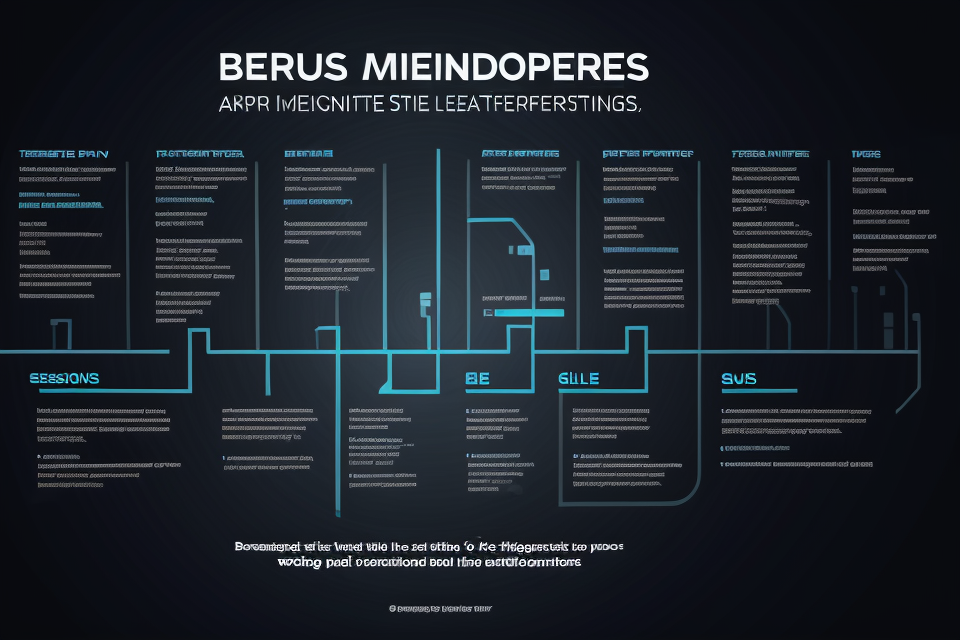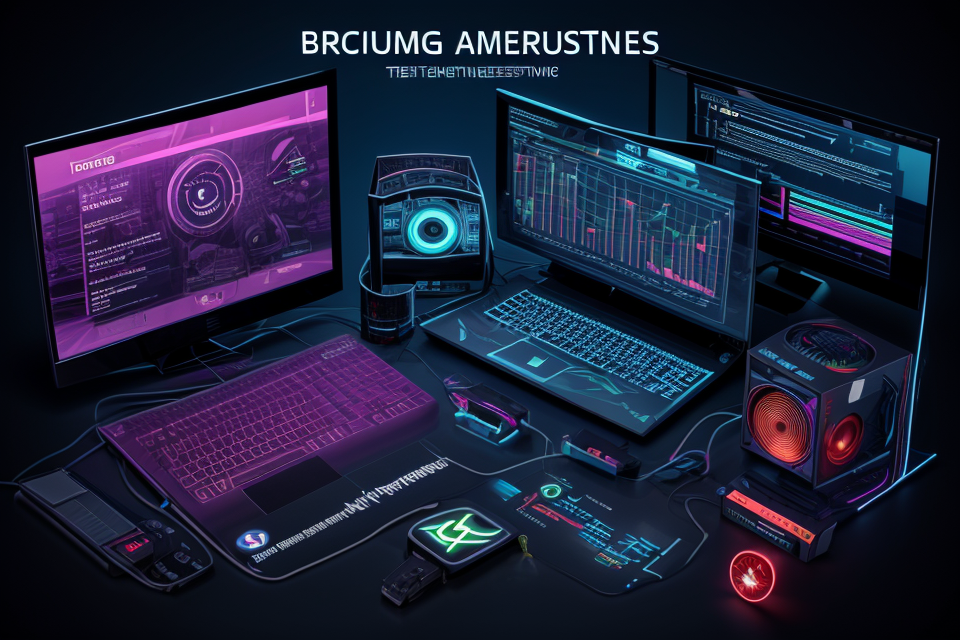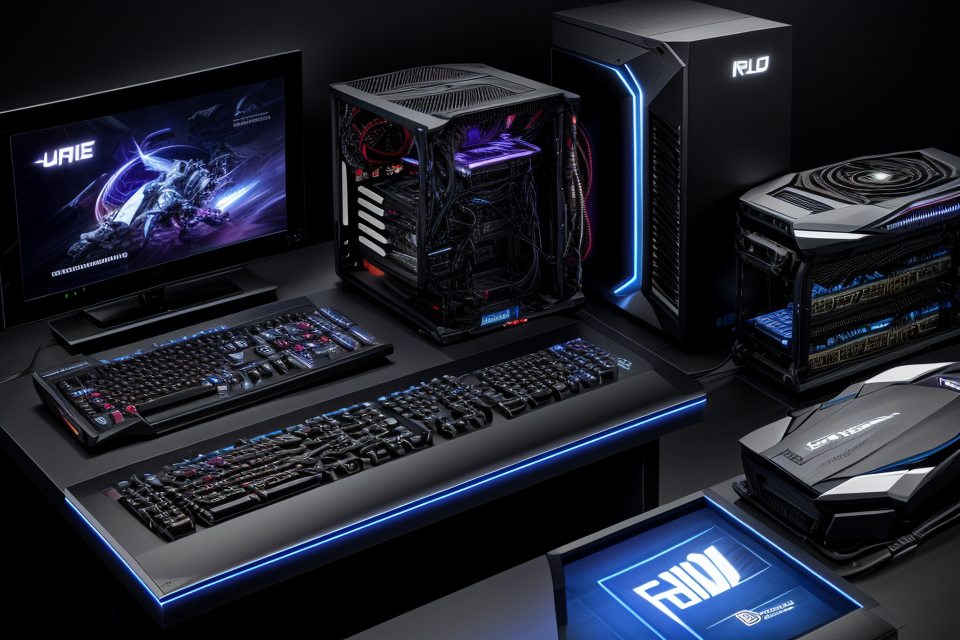
Are you ready to take your gaming experience to the next level? Look no further than the graphics processing unit (GPU) – the unsung hero of any gaming setup. The GPU is responsible for rendering the images and animations that bring your games to life, and its performance can make or break your gaming experience. But just how much does the GPU affect gaming performance? In this article, we’ll explore the significant role that GPUs play in enhancing gaming performance, and how they can help you achieve the smoothest, most immersive gaming experience possible. So grab a bag of Mountain Dew and get ready to geek out – it’s time to dive into the world of GPUs and gaming!
Understanding the Basics of GPUs and Their Impact on Gaming
The Fundamentals of GPUs
A Graphics Processing Unit (GPU) is a specialized processor designed to accelerate the creation and rendering of images, videos, and other graphical content. It plays a crucial role in enhancing the overall gaming performance by offloading the workload from the Central Processing Unit (CPU) and delivering smooth, high-quality graphics. In this section, we will delve into the fundamentals of GPUs and their role in gaming.
Key Components of a GPU
- Rendering Pipeline: A series of stages that transform the input data into a 2D image, including vertex shaders, geometry shaders, rasterization, and pixel shaders.
- Unified Shaders: Combined vertex and pixel shaders that can execute a wide range of operations, simplifying the design and improving performance.
- Compute Units: Specialized cores that perform general-purpose computations, such as physics simulations, AI calculations, and procedural generation.
- Memory: Fast, on-chip memory for storing data temporarily during rendering, as well as slower, off-chip memory for long-term storage.
- Output: The final rendered image or a stream of data to be sent to a display device.
Differences between CPUs and GPUs
- Parallel Processing: GPUs are designed to handle a large number of calculations simultaneously, making them well-suited for tasks like rendering graphics or running AI algorithms. CPUs, on the other hand, are optimized for handling sequential processing and handling complex tasks with fewer but more powerful cores.
- Memory Architecture: CPUs typically have a smaller, faster cache memory and a larger, slower main memory, while GPUs have a larger, faster shared memory that is partitioned among the processing cores. This architecture enables GPUs to process multiple data elements in parallel, while CPUs focus on processing data sequentially.
- Programming Models: CPUs use a traditional von Neumann architecture, with instructions fetched from memory and executed in order. GPUs use a more flexible programming model, allowing developers to use threads and parallel processing to achieve better performance. This requires specialized knowledge and techniques, such as CUDA for NVIDIA GPUs or OpenCL for AMD GPUs.
By understanding the fundamentals of GPUs and their differences from CPUs, we can appreciate the role they play in enhancing gaming performance and the challenges faced by game developers in optimizing their software for these powerful processors.
GPUs and Gaming Performance
The role of Graphics Processing Units (GPUs) in enhancing gaming performance cannot be overstated. GPUs are specifically designed to handle the complex mathematical calculations required for rendering images and video, which makes them an essential component in gaming systems. In this section, we will explore the importance of GPUs for gaming, how they influence frame rates and gameplay, and their impact on graphical quality and visuals.
- The importance of GPUs for gaming:
- GPUs are responsible for rendering images and video, which are critical components of gaming.
- The more complex the graphics, the more demanding the game becomes, and the more powerful the GPU needs to be to handle it.
- A high-performance GPU can make a significant difference in the overall gaming experience, as it can handle more complex graphics and provide smoother gameplay.
- How GPUs influence frame rates and gameplay:
- Frame rate refers to the number of images displayed per second in a game.
- A higher frame rate results in smoother gameplay, which is crucial for a seamless gaming experience.
- GPUs are responsible for rendering images and video, which directly impacts the frame rate.
- A powerful GPU can render images and video faster, resulting in higher frame rates and smoother gameplay.
- The impact of GPUs on graphical quality and visuals:
- GPUs are responsible for rendering images and video, which directly impacts the graphical quality and visuals in a game.
- A powerful GPU can render images and video at higher resolutions, resulting in better graphical quality and more realistic visuals.
- GPUs can also handle more complex graphics, such as shadows, reflections, and particle effects, which enhance the overall visual experience in a game.
- In summary, a powerful GPU is crucial for a seamless and immersive gaming experience, as it can handle more complex graphics and provide smoother gameplay.
Comparing the Performance of Different GPUs
NVIDIA and AMD: The Top Contenders
NVIDIA and AMD are two of the most well-known brands in the market when it comes to graphics processing units (GPUs) for gaming. Both companies have a long history of producing high-quality GPUs that cater to the needs of gamers and other professionals. In this section, we will take a closer look at these two brands, their popular models, and the key differences between them.
An Overview of NVIDIA and AMD
NVIDIA is a technology company that was founded in 1993, while AMD was founded in 1969. Both companies have a significant presence in the market and have been competing against each other for years. They have both developed a wide range of GPUs that cater to different segments of the market, from entry-level to high-end gaming.
Popular Models from Each Brand
Some of the most popular models from NVIDIA include the GeForce RTX 3080, GeForce RTX 3070, and GeForce GTX 1660 Super. On the other hand, AMD has models like the Radeon RX 6800 XT, Radeon RX 6700 XT, and Radeon RX 6900 XT. These models are known for their high performance and advanced features that cater to the needs of gamers and other professionals.
Key Differences between NVIDIA and AMD GPUs
While both NVIDIA and AMD offer high-quality GPUs, there are some key differences between them. One of the most significant differences is in the architecture of their GPUs. NVIDIA GPUs are known for their advanced CUDA architecture, which enables them to offer better performance in certain games and applications. On the other hand, AMD GPUs are known for their superior memory bandwidth, which makes them ideal for running memory-intensive applications.
Another key difference between NVIDIA and AMD GPUs is in their driver support. NVIDIA is known for providing excellent driver support, which ensures that their GPUs work seamlessly with a wide range of games and applications. AMD, on the other hand, has also made significant improvements in their driver support, but they are still catching up with NVIDIA in this regard.
Overall, both NVIDIA and AMD offer high-quality GPUs that cater to the needs of gamers and other professionals. While there are some key differences between them, the choice between these two brands ultimately depends on the specific needs and preferences of the user.
The Impact of CUDA and Radeon Technologies
- CUDA and its significance for NVIDIA GPUs
- CUDA (Compute Unified Device Architecture) is a parallel computing platform and programming model developed by NVIDIA.
- It enables NVIDIA GPUs to process and execute general-purpose computing tasks in addition to graphics rendering.
- This allows NVIDIA GPUs to leverage their massive parallel processing power for tasks such as scientific simulations, machine learning, and of course, gaming.
- CUDA-enabled GPUs can run CUDA-compatible applications and games, providing significant performance boosts in these scenarios.
- Radeon Technologies and its impact on AMD GPUs
- Radeon Technologies Group (RTG) is a division of AMD (Advanced Micro Devices) responsible for the design and development of its graphics cards and related technologies.
- AMD GPUs also offer parallel computing capabilities, but the architecture and programming model are different from NVIDIA’s CUDA.
- AMD’s graphics cards support a range of programming languages and APIs, including the proprietary AMD Accelerated Parallel Processing (AMD APP) and the open-source OpenCL (Open Computing Language).
- RTG’s focus on advanced features like FreeSync (adaptive refresh rate technology) and Radeon Software (driver and utility suite) further enhances the gaming performance of AMD GPUs.
- The influence of these technologies on gaming performance
- The performance of a GPU in gaming is heavily influenced by the architecture, parallel processing capabilities, and optimizations provided by the manufacturer’s technologies.
- NVIDIA’s CUDA and AMD’s Radeon Technologies play a crucial role in determining the performance of their respective GPUs in gaming scenarios.
- These technologies enable the GPUs to leverage their parallel processing power for gaming tasks, resulting in smoother frame rates, reduced input lag, and enhanced overall gaming experience.
- Additionally, optimizations for specific games and game engines (such as Unity and Unreal Engine) can further enhance the performance of GPUs with these technologies.
How Much GPU Memory Affects Gaming Performance
- The role of GPU memory in gaming
- GPU memory, also known as VRAM (Video Random Access Memory), plays a crucial role in gaming performance as it is responsible for storing the visual data that is being rendered on the screen.
- As the graphics in games become more complex and detailed, the demand for GPU memory increases, and therefore, it becomes a critical factor in determining the gaming performance.
- How much GPU memory is required for optimal gaming performance
- The optimal amount of GPU memory required for gaming depends on various factors such as the game’s resolution, graphics quality, and the number of graphics cards in SLI or Crossfire configuration.
- Generally, 4GB of GPU memory is considered the minimum requirement for gaming, but for high-end games and ultra-high-definition resolutions, 8GB or more is recommended.
- The impact of VRAM on frame rates and gameplay
- VRAM has a direct impact on the frame rates and gameplay as it determines how much visual data can be stored in the GPU memory before it needs to be swapped out to the system memory.
- With insufficient VRAM, the game may experience stuttering, lagging, or even crashes, which can result in a poor gaming experience.
- Therefore, it is essential to have an adequate amount of VRAM to ensure smooth gameplay and high frame rates.
Factors Affecting GPU Performance in Gaming
The Role of Resolution and FPS
- The influence of resolution and frame per second (FPS) on GPU performance
- The higher the resolution, the more pixels the GPU needs to render, leading to increased workload and heat generation.
- Frame per second (FPS) is the number of frames displayed per second, affecting smoothness and fluidity of gameplay.
- Both resolution and FPS have a direct impact on GPU performance, and choosing the right balance is crucial for optimal gaming experience.
- How adjusting resolution and FPS settings can impact gaming experience
- Higher resolution results in sharper images, but can lead to reduced frame rates and lowered performance.
- Adjusting FPS settings can increase performance by reducing the workload on the GPU, but at the cost of lower image quality.
- Balancing these settings based on the user’s preferences and hardware capabilities is key to achieving a seamless gaming experience.
- The importance of balancing resolution and FPS for optimal performance
- Over-emphasizing resolution at the cost of FPS can lead to a choppy and laggy gaming experience.
- Conversely, prioritizing FPS over resolution can result in a less visually appealing game.
- Finding the right balance between resolution and FPS is essential for a smooth and enjoyable gaming experience.
The Impact of Graphics Quality Settings
The graphics quality settings in a game can have a significant impact on the performance of the GPU. These settings determine the level of detail and complexity in the visuals of the game, including the textures, lighting, and shadows. Higher graphics quality settings generally require more processing power from the GPU, which can lead to a decrease in frame rates and slower gameplay.
- The effect of graphics quality settings on GPU performance: When graphics quality settings are set to high or ultra, the GPU has to work harder to render the graphics. This can cause the GPU to use more power and generate more heat, which can result in a decrease in performance and even hardware failure if not properly cooled.
- How adjusting graphics settings can impact frame rates and gameplay: Lowering graphics quality settings can improve frame rates and reduce lag in the game. However, this can also result in a less immersive gaming experience with lower visual quality. Finding the right balance between graphics quality and performance is crucial for a smooth and enjoyable gaming experience.
- Balancing graphics quality with GPU performance for the best gaming experience: To achieve the best gaming experience, it is important to balance the graphics quality settings with the performance of the GPU. This can be done by adjusting the settings based on the capabilities of the GPU and the desired level of visual quality. Overclocking the GPU can also help improve performance and handle higher graphics quality settings. However, it is important to be cautious when overclocking to avoid damage to the hardware.
Upgrading Your GPU for Improved Gaming Performance
How to Choose the Right GPU for Your Needs
Choosing the right GPU for your gaming needs is crucial to ensuring optimal performance and an immersive gaming experience. With so many options available in the market, selecting the right GPU can be a daunting task. However, by considering a few key factors, you can make an informed decision that suits your budget and requirements.
Factors to consider when selecting a GPU for gaming
When selecting a GPU for gaming, there are several factors to consider. These include:
- Budget: The cost of the GPU is an essential factor to consider when selecting a GPU. Set a budget and look for options that fit within your budget while offering the performance you need.
- Compatibility: Ensure that the GPU is compatible with your computer’s motherboard and power supply unit (PSU). Check the specifications of your computer and the GPU to ensure they are compatible.
- Performance: Consider the performance of the GPU in terms of the number of CUDA cores, memory size, and clock speed. These factors affect the GPU’s ability to handle complex graphics and rendering tasks.
- Size and form factor: If you have limited space in your computer case, consider the size and form factor of the GPU. Some GPUs are larger and require more space, while others are smaller and more compact.
Popular gaming GPUs and their performance comparisons
There are several popular gaming GPUs available in the market, each with its unique performance characteristics. Some of the popular gaming GPUs include:
- NVIDIA GeForce RTX 3080
- AMD Radeon RX 6800 XT
- NVIDIA GeForce RTX 3070
- AMD Radeon RX 6700 XT
- NVIDIA GeForce RTX 3060 Ti
When comparing these GPUs, it is essential to consider their performance in terms of the number of CUDA cores, memory size, clock speed, and power consumption.
Tips for selecting the right GPU for your budget and needs
To select the right GPU for your budget and needs, consider the following tips:
- Research and compare different GPUs based on their performance, compatibility, and price.
- Check for user reviews and benchmarks to get an idea of how the GPU performs in real-world scenarios.
- Consider your future needs and ensure that the GPU you choose can handle your requirements as they evolve.
- Check for any promotions or discounts that may be available to help you save on the cost of the GPU.
In conclusion, choosing the right GPU for your gaming needs requires careful consideration of several factors, including budget, compatibility, performance, and size. By taking the time to research and compare different options, you can make an informed decision that will enhance your gaming experience and provide optimal performance.
The Benefits of Upgrading Your GPU
Upgrading your GPU is one of the most effective ways to improve your gaming performance. Here are some of the benefits of upgrading your GPU:
Improved Gaming Performance
Upgrading your GPU can significantly improve your gaming performance. A high-performance GPU can handle more complex graphics and processes, resulting in smoother gameplay and faster load times. This means that you can enjoy a more seamless and immersive gaming experience, with fewer lag issues and stutters.
Enhanced Graphical Quality and Visuals
Upgrading your GPU can also enhance the graphical quality and visuals of your games. High-performance GPUs are capable of rendering more detailed textures, higher resolutions, and more realistic lighting effects. This can make your games look more vivid, lifelike, and immersive, adding to your overall gaming experience.
Long-term Benefits of Investing in a High-performance GPU for Gaming
Investing in a high-performance GPU for gaming can have long-term benefits as well. As technology advances, new games and software applications will require more powerful GPUs to run smoothly. By upgrading your GPU now, you can ensure that your gaming system will be able to handle the demands of future games and applications. Additionally, a high-performance GPU can also be useful for other tasks, such as video editing, graphic design, and other graphics-intensive applications.
Overall, upgrading your GPU can provide significant benefits for your gaming performance, visual quality, and long-term compatibility with future technology.
FAQs
1. What is a GPU and how does it affect gaming performance?
A GPU, or Graphics Processing Unit, is a specialized processor designed to handle the complex calculations required for rendering images and video. In gaming, the GPU is responsible for rendering the game world, characters, and objects in real-time. A more powerful GPU can handle more complex graphics and render them at higher resolutions and frame rates, resulting in smoother and more visually appealing gameplay.
2. How important is a GPU for gaming compared to other components like the CPU?
While a fast CPU is important for gaming, the GPU is typically the most critical component for achieving high levels of performance. This is because the GPU is responsible for rendering the visuals, and modern games rely heavily on complex graphics and special effects. A powerful GPU can offload some of the work from the CPU, allowing for smoother gameplay and higher frame rates.
3. Can an older or lower-end GPU limit the performance of a gaming PC?
Yes, an older or lower-end GPU can limit the performance of a gaming PC. Even if you have a fast CPU and plenty of RAM, a weak GPU will struggle to keep up with the demands of modern games. This can result in lower frame rates, stuttering, and other performance issues. It’s important to ensure that your GPU is up to the task of handling the games you want to play.
4. How do I know if my GPU is sufficient for gaming?
To determine if your GPU is sufficient for gaming, you can check the system requirements for the games you want to play. Most games will list the minimum and recommended GPU specifications, such as the GPU model and the amount of VRAM. If your GPU meets or exceeds these requirements, it should be able to handle the game’s graphics at a reasonable frame rate.
5. How can I improve my gaming performance by upgrading my GPU?
Upgrading your GPU is one of the most effective ways to improve your gaming performance. A more powerful GPU can handle more complex graphics and render them at higher resolutions and frame rates. To upgrade your GPU, you will need to purchase a new one that is compatible with your motherboard and power supply. Once you have installed the new GPU, you may need to update your drivers and configure your settings to take full advantage of its capabilities.


